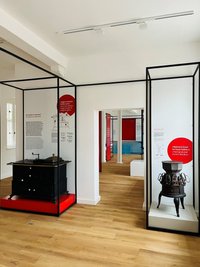Schwarzweißfotografie. Dieses Bild, aufgenommen um das Jahr 1910, zeigt die obere Hauptstrasse in Bendorf mit Blick auf die Medardus Kirche. Im Vordergrund zu sehen ist die ehemalige katholische "Kinderverwahrschule". Davor noch sichtbar ist der "Plenzerpfad", welcher in den 1920er Jahren zur Bahnhofstraße ausgebaut wurde. In der Mitte im Hintergrund dargestellt ist das Haus von Johann Kahn, welches dem Luftangriff auf Bendorf am 31.12.1944 zum Opfer fiel.
en

